5.1 Definitions and terminology
The six types of institutions
Objects, text carriers and texts have survived from six types of institutions. There are great variations within each type, in their origins and their aims as well as in their organisation. The definitions given here should be considered to be broad descriptions, see 5.5 for specialised literature and websites.
Chapel: a chapel is a space in which an altar has been placed, whether in the form of an independent building, or as a part of or annex to a parish church or monastic church or castle. The liturgical celebrations in a chapel are performed by one or more members of the clergy, who may or may not be paid for this service from a fund (reserved for this purpose), a so-called chantry. Multiple chantries can be founded on a single altar. Founders of chapels and chantries were a (noble) family, a confraternity, the city council, local residents, interested parties in a place of pilgrimage, etc. The function of chapels varies greatly. For local residents who live far from their parish church, the independent chapel can fulfill functions of the parish if the priest of the chapel is given the right to administer one or more sacraments, see MeMO institution ID 428.

Fig. 1. The Onze Lieve Vrouwekerk in Tholen was a chapter church as well as a parish church. Floor slabs from both canons and parishioners remain, MeMO institution ID 850
Chapter: an institution that was founded to enable its members, the canons, to perform the daily recitation of the Liturgy of the Hours. Also called the Divine Office, the Hours are the daily prayers to be recited or sung at fixed hours of the day. Two types of chapter can be distinguished:
- the cathedral chapter, which was connected to a cathedral, i.e. an episcopal church. In the diocese of Utrecht this is the Domkerk or the St. Maartenskerk in the city of Utrecht.
- the collegiate chapter, founded in an independent church or in a parish church (see for instance fig. 1 and the chapter of St Mary in Utrecht: MeMO institution ID 127).
Please note: in the MeMO database parish churches with chapters have been included under Chapter, not under Parish.
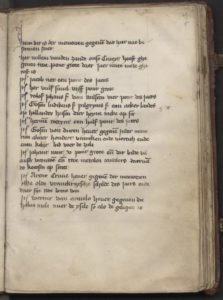
Fig. 2. Miscellany with various texts among which a register of gifts (f. 7r) of the ‘schepenmemorie’ of Kampen. Mostly members of ruling families of the town belonged to this confraternity, MeMO text carrier ID 376
Confraternity/guild: a confraternity or guild is an association that was founded to promote the care for the souls of the living and deceased brothers and sisters. The aims of confraternities include the promotion of the commemoration of a tenet of faith (Sacrament confraternities), the adoration of Mary or another saint, and the propagation of a special devotion (the prayer of the rosary). Confraternities or guilds were usually based in the building of another institution such as a parish church or a monastery.
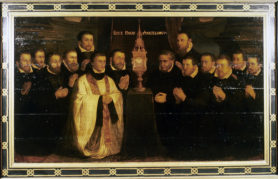
Fig. 3. Memorial painting with members of the Confraternity of the Blessed Sacrament of the Nieuwe Kerk in Amsterdam (?) kneeling on both sides of a monstrance (1570-1578), MeMO memorial object ID 643
They had their own altar services. Some had a chapel and/or altar of their own, some did not. For the liturgical services a confraternity or guild could found a chantry, which had its own chaplain, but this was not obligatory. A confraternity could also unite fellow craftsmen, in which case it doubled as a trade guild (fig. 2 and 3).
Hospital or orphanage: these are institutions for people who required special care, such as the elderly, the sick and orphans. These could be independent institutions or institutions that were connected to a monastery, for example. Initially these institutions usually serviced multiple categories of people in need. Many institutions specialised over the years and became orphanages, for example, or specialised hospitals that catered to specific groups, see MeMO institution ID 317 and ID 705.
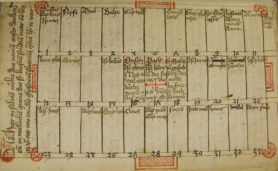
Fig. 4. Drawing of the churchyard of the convent of St Agnes in Amersfoort. When the convent was enlarged, part of the churchyard had to be used. The bones of the sisters who were buried there were therefore reburied in the middle of the new churchyard, MeMO text carrier ID 12
Monastery: the term monastery has been used in the MeMO database as an umbrella term for all sorts of institutions for people who devoted their lives to God. The following terms are used in the detailed descriptions of the monastic institutions:
- abbey: an institution headed by an abbot or abbess, see MeMO institution ID 82 and fig. 5a and 5b.
- monastery: a monastic institution of the ancient orders (Benedictines, Cistercians, Canons Regular) that did not have the status of abbey, see MeMO institution ID 414.
- commandery: local establishment of a knightly order. The two most important ones in the Netherlands were the Knightly Order of Saint John of Jerusalem, also known as Knights Hospitallers, and the Order of the Brothers of the German House of Saint Mary in Jerusalem, also known as the Teutonic Order, see fig. 5c.
- house: a religious community of brothers and sisters of the Common Life, that did not live by one of the traditional monastic rules,
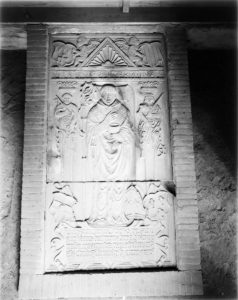
Fig. 5b. Petrus van Zuyren († 1563), Norbertine abbot of Mariënwaard Abbey, MeMO institution ID 830. Both on this floor slab and on a stained glass window in the Janskerk in Gouda, he is shown wearing the chasuble of a priest. The mitre and crozier refer to his dignity as abbot, MeMO memorial object ID 2021 and ID 887
- beguinage: a community of beguines, whether in the form of a court beguinage, or as a beguine house, see MeMO institution ID 366.
- convent: all other monastic institutions, including those of the mendicant orders.
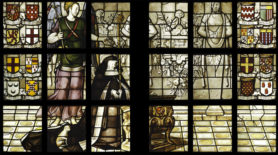
Fig. 5a. Elburga van den Boetzelaer († 1568), Benedictine abbess of Rijnsburg Abbey, MeMO institution ID 592. Detail of a stained glass window in the Janskerk in Gouda, MeMO memorial object ID 874
Parish: this term denotes an ecclesiastical (geographic) area in which the parish priest, possibly with the assistance of other priests, had the care of the souls of the local residents, the parishioners. The centre of the parish was the parish church, where the liturgical celebrations took place, and which had been given burial rights. The deceased were buried in the church or in the churchyard next to the church. There could be one or more parishes in a town or city.

Fig. 6. The parish church of Bolsward already existed in the 11th century and still houses a large number of medieval floor slabs today, MeMO institution ID 665
Please note: in the MeMO database parish churches with chapters have been included under Chapter, not under Parish.
The tasks of these institutions in the commemoration of the dead
The great majority of the institutions mentioned had a function in the commemoration of the dead, both for their own members, but for others as well. In many cases monasteries and hospitals had a chapel and burial place of their own at their disposal where they could bury and commemorate their own members and the deceased who had wished to be buried in the institution (if the institution had received permission from the ecclesiastical authorities). Confraternities or guilds usually had their own burial vault or a number of burial places in the church where they were congregated.
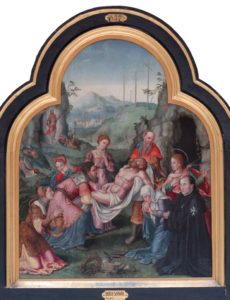
Fig 5c. Triptych with the devotional portrait of Philips van Hogesteyn, Haarlem commander of the Knightly Order of St John of Jerusalem, see MeMO institution ID 288 and MeMO memorial object ID 739
Definitions relevant to the descriptions of the institutions
The types of institution that are included in the MeMO database show much diversity within each type, and within this diversity there are different names for the same variant. Also, there are all sorts of variations in the titles of the officials within each type of institution.
The table below shows only the terms and titles that occur in the MeMO database. For specialised literature see 5.5 Literature and websites.
| Term | Explanation |
| Abbey | Monastery with an abbot or an abbess as its superior |
| Abbot/Abbess | Superior of a monastery, especially of the ancient orders, with the highest level of independence (fig. 5a and 5b) |
| Advowson | The right to have the functionary of an ecclesiastical office receive his living from that office and to propose him for appointment to the ecclesiastical authorities. Synonym: collation. |
| Arch diocese | 1. Ecclesiastical province, the largest jurisdiction of the Latin church, headed by an archbishop. The ecclesiastical province is divided into dioceses 2. Diocese directly ruled by an archbishop |
| Bailiff | Head of a bailiwick |
| Bailiwick | Commandery of which the head supervised the commanderies in its region |
| Beguines (or Beguins) and Beghards (or Beguards) | Men/women who unite to lead a religious life without taking monastic vows and with the right to own private property |
| Bishop | Head of a diocese, who has both the power of ordination (the ordainment of priests and the consecration of churches and altars) and the power of jurisdiction and administration in his diocese |
| Brothers/sisters of the Common Life | Clergy and laymen/women who, inspired by the Modern Devotion, led a religious life in common possession of properties but without taking monastic vows |
| Canons and canonesses regular | Members of an order that observes the Rule of St Augustine |
| Chantry | A foundation consisting of a reserved capital with a its own administrative regulations, to support a priest for an altar service. |
| Chapel | Building or part of a building in which an altar was founded |
| Chaplain | Priest performing the altar service that is provided for in a chantry founded for that purpose |
| Chapter | 1. Institution founded to enable its members, the canons, to perform the daily liturgy of the Hours. The chapter can be established in a church of its own or in a parish church 2. Supralocal association of monasteries who live by the same rule and practices, that inspect each other through visitations |
| Chapter of Sion | Supralocal association of monasteries of observant monasteries of canons and canonesses regular in the county of Holland |
| Chapter of Venlo | Supralocal association of monasteries of observant monasteries of canonesses regular, primarily in the diocese of Liège |
| Chapter of Windesheim | Supralocal association of monasteries of observant monasteries of canons and canonesses regular, founded in 1395 |
| Clergy (regular) | Men who took vows to follow a rule approved by the church |
| Clergy (secular) | Men who received (lower and/or higher) Holy Orders |
| Collation | The right to have the functionary of an ecclesiastical office receive his living from that office and to propose him for appointment to the ecclesiastical authorities. Synonym: advowson. |
| Collegiate church | Church in which a chapter had taken residence |
| Commandery | Independent establishment of a military order such as the Teutonic Order |
| Commander | Administrative superior of a commandery (fig. 5c) |
| Confraternity or guild | Association of clergy and/or laymen founded e.g. to the honour of God and his saints and to keep an altar service. Often called a guild |
| Convent | Religious community, though not an abbey, monastery, commandery or house |
| Curate | The clergyman to whom the care of the soul in a parish is entrusted. Synonym: parish priest |
| Dean | 1. In a chapter: priest-canon who is responsible for the daily running of the chapter under the authority of a provost 2. Head of a deanery, responsible for supervision and jurisdiction, who is usually a curate in one of the parishes belonging to the deanery |
| Deanery | District (subdivision of a diocese) that rules a number of parishes |
| Diocese | Part of an Arch diocese, ruled by a bishop |
| Divine Office | The official prayers that are to be recited or sung seven times per day, guided by the requirements of the liturgical year. Synonym: Liturgy of the Hours |
| Double monastery | A monastery that combines a community for monks with an annexed community for nuns, under the unitary leadership of the head of the monks’ monastery (usually an abbot) |
| Enclosure | Separation from the outside world of certain areas of a monastery, where enclosed nuns remain permanently and to which outsiders have no access |
| Guild | See Confraternity or guild |
| Hospital | Foundation for the care for one or more categories of those in need |
| Hours, Liturgy of the Hours | The official prayers that are to be recited or sung seven times per day, guided by the requirements of the liturgical year. Synonym: Divine Office |
| House | Religious community of brothers and sisters of the Common Life |
| Indulgence | Originally: full or partial remission of ecclesiastical penance imposed at confession. In the course of time it also came to mean a shortening of the souls’ stay in purgatory |
| Military order | Order that emerged during the crusades that consisted of knights (who do battle), priests and brothers, all three of which took monastic vows |
| Modern Devotion, Devotio Moderna | Religious revival among religious people and laymen from the end of the fourteenth century emerging in the Northern Netherlands |
| Monastery | Establishment of persons who choose to separated themselves from the world to lead a life devoted to God and who take the three vows of poverty, obedience and chastity |
| Monastic Order: Mendicant order | Order of conventuals who maintain the vow of poverty not only individually, but also collectively, by begging and devoting themselves to the care for the soul |
| Monastic Rule | Ecclesiastically sanctioned rule by which monks and nuns lived. The major rules in late-medieval Western Europe are the Rule of St Benedict, of St Augustine and the first and second rules of St Francis |
| Monk | Men who have taken the three monastic vows of poverty, obedience and chastity (members of the Military Orders and Canons regular are not considered monks) |
| Nun | Woman who has taken the three monastic vows of poverty, obedience and chastity |
| Observance | Renewed strict compliance with a monastic rule |
| Orphanage | See hospital |
| Parish | Basic unit of an ecclesiastical organisation for the care for the soul: the place where the parishioners receive the sacraments |
| Pilgrimage | Journey undertaken with a religious aim, especially of visiting a place with a specific cult |
| Prior | 1. In ancient orders: second in command of the monastic community; the superior is an abbot. 2. In more recent orders: monastic superior. |
| Prioress | Superior of a women’s abbey, either independently, or under the rule of an abbot |
| Provost | 1. Superior of a secular chapter. 2. In some ancient orders: Superior of a monastic establishment that is dependent on an abbey |
| Religious order: contemplative order | Order of conventuals who consider prayer for the church, the world and their patrons their most important task |
| Secular chapter of canonesses | Secular chapter inhabited by canonesses of noble birth |
| Semi-religious people | Common term (but incorrect in canon law) for men and women who lead a religious life but have not taken the three vows |
| Tertiaries | Men/women who either individually or collectively lead a religious life and observe the third Rule of St Francis, which is intended for laymen |

